This article is also available in: English
3月の末にカリフォルニア州サンディエゴで開催された「第31回 テクノロジーと障害者国際会議(31st Annual International Technology and Persons with Disabilities Conference) 」に出席しました。
この国際会議では、職場や学校など日常生活で障害者の能力をサポートしてくれる最新テクノロジーについて情報を得ることができます。
会場にはIBM、マイクロソフト、Googleなど大手ハイテック企業のブースがセットされており、3日間にわたって自社の取り組みについてプレゼンしていきます。
企業のほかにも政府機関や教育機関も参加しており、導入している施策について紹介しています。
参加者、約3,000人のうち障害のある当事者は約半分を占めているというこの国際会議。
中でも、白杖をついた視覚障害の方をよく見かけました。
テクノロジーの進歩によって多くの人の生活が便利になりますが、視覚障害者にとっては特にその影響力が大きいのだろうと感じました。
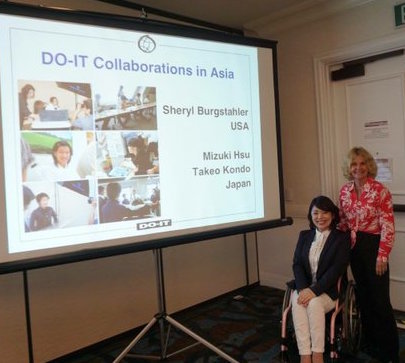
もともと私は参加者の1人としてこの会議に登録していたのですが、
ワシントン大学で取材したDO-ITのSheryl Burgstahler氏(*1)から「プレゼンターとして加わってほしい」という嬉しい依頼が!
DO-ITプログラムは日本を含むアジア各国でも活動しており、Sheryl氏がその取り組みについて話すプレゼンのなかで
私から日本の障害者の教育と雇用について少し話をさせていただきました。
プレゼンのあと何人かの出席者から質問がありました。
そのうちの1つが「雇用に関して、どんなところがアメリカ企業と日本企業で違いますか?」というもの。
私はシラキュースで障害者雇用の研究を始める前に、東京にある日系企業と米系企業の日本支社を15社訪問しました。
そこで感じたのは、米系企業の方が現在の日本の障害者雇用に対して課題意識をもっているということ。
課題を解決するために新しい取り組みを始めたり、働きやすい職場環境を作るためにアクションを起こしているところが多いです。
またそれだけに満足せず、もっと変わっていかなければならないことを自覚している様子がわかり、
私が感じている障害者雇用の課題にも積極的に耳を傾けてくれました。
一方、日系企業の方はもっと保守的な態度のところが多かったです。
「すでにこんな事もこんな事もしました」と淡々と説明され、障害者雇用に関してもっと先進的に取り組みたいという様子はあまり見られませんでした。
ある米系企業で実施していた障害者の能力を高める取り組みを紹介をしたところ、「うちでするのは難しいですね」と即答され、必要以上の取り組みには興味がないんだなと感じました。
これはほんの一例ですが、日系企業と米系企業で障害者雇用への課題認識に大きな差があることをこのとき実感しました。
私のプレゼンは会議の1日目に終了し、残りは企業のプレゼンや展示会場をウロウロしました。
ここで展示会場で見つけた2つの商品を紹介します!
1. 点字スマートウォッチ
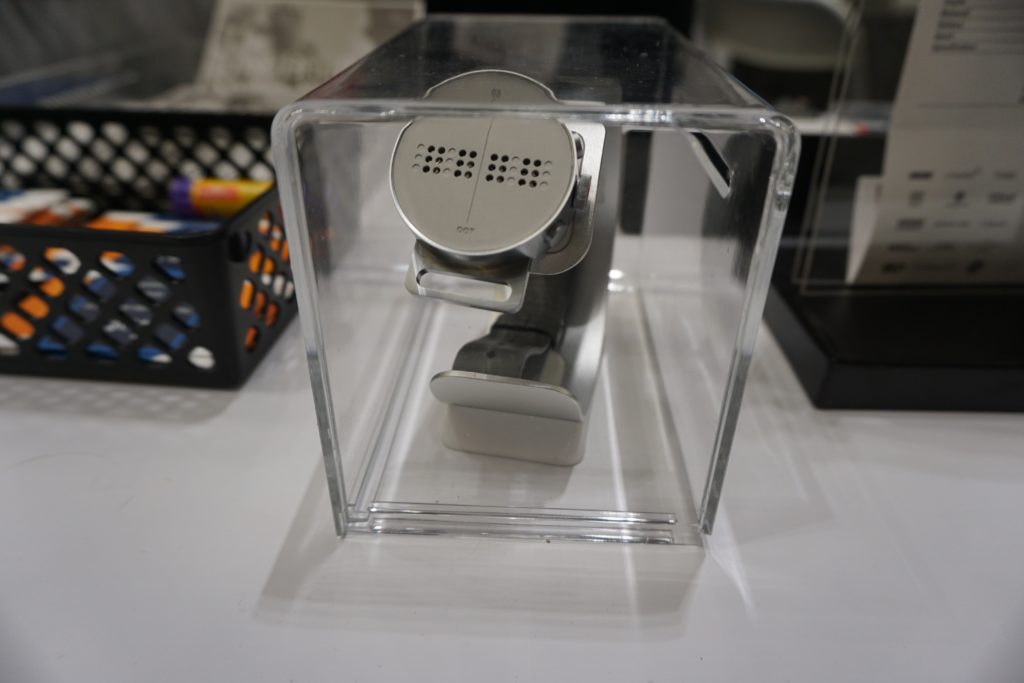
以前ネットのニュースで読んだことがあったのですが、韓国の会社「Dot Incorporation」が開発した点字のスマートウォッチを会場で見ることができました。
このデザインとってもおしゃれですよね。
腕時計の他にもスマートフォンサイズのものも。
これは、図表のイメージを指で触って分かるようになってるんですって!
詳しい情報は公式サイトからご確認ください。 http://fingerson.strikingly.com/
2. UbiDuo
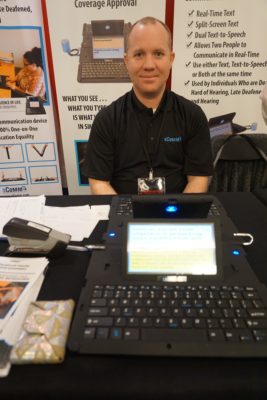
UbiDuoというのは聴覚障害者とのコミュニケーションツール。
こちらを作ってる企業「sComm」の社長 Jasonさん(写真)も聴覚障害者で、デモンストレーションをしながら使い方を教えてくれました。
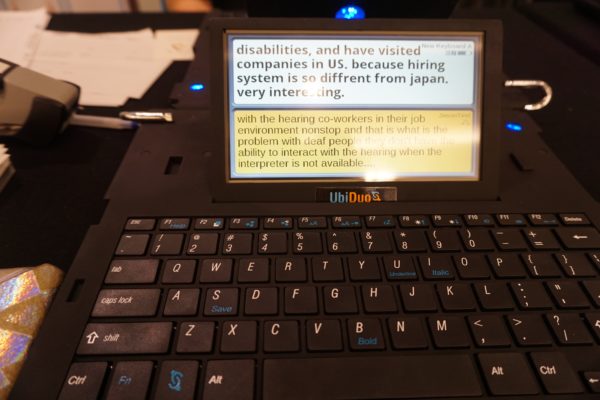
キーボードが私の方とJasonさんの方にそれぞれあり、私が書いた文章は写真の白い部分(スクリーン上)に書き出され、Jasonさんが書いた内容は黄色い部分(スクリーン下)に書き出されます。
読み書きがとってもスムーズで簡単にコミュニケーションを取ることができます。
2つのキーボードは繋がっていて折りたたんで持ち運び可能。職場でも活躍しそう!
詳細は公式サイトからご確認ください。 https://www.scomm.com/
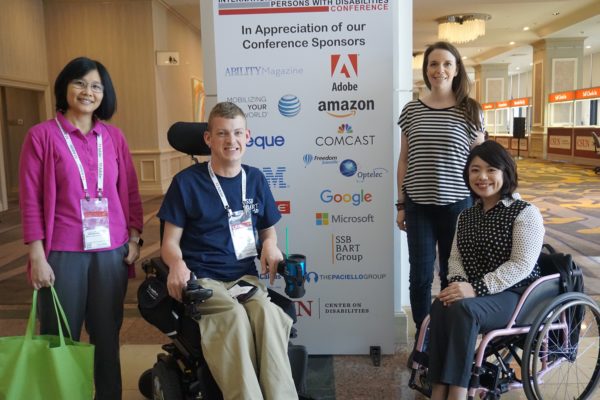
この会議では情報の収穫だけでなく、これまでの取材でお会いした方々との再会があり、また新しい出会いもたくさんありました。
これをエネルギーにまた頑張らなきゃ!
日本に帰った後も年に1回、この会議にはぜひ参加したいです…!
*1 DO-ITの取材(Part 1~3)は以下から読むことができます

Oh, Mizuki,
I have so many things to tell you, and we have only first met. If you don’t know these people already it might help you to get to know them:
Oda, Yuriko who writes on You Tube about traveling in Japan using a wheelchair
Nagaya, , Hirokazu who owns and operates Piro Racing a clothing store with clothes for those using a wheelchair. Hirokazu was injured when he was a F1 racer and is now working out of his wheelchair.
Okimura, Sakura and her daughter Yukiko Okimura. Yukiko has a Cafe in Yokohama with her mother. Sakura is paralyzed from the chest down. She was in a bicycle accident when her daughter Yukiko was in Elementary School. Sakura’s husband had already died by the time Sakura became paralyzed. They are both two very strong women with very strong opinions. That’s it for the Japanese I know.
Josh Grisdale is a Canadian. He has been in Japan for ten years now. He has the blog Accessible Japan and was born with cerebral palsy and last but not least there is me.
You know if we all put our heads together we could do a lot before the Olympics and Para-Olympics in Tokyo 2020. I’m sure there are a lot of people you know that I don’t, and the people I named here probably know more people than the two of us. If we put our heads together we could only make Japan a better country for the Worlds future generations, don’t you think?
Now for a little bit about myself. I came to Japan forty years ago after graduating from the University of Washington, with a major in International Relations. I came to Japan to work at the Elizabeth Saunders Home an orphanage located in the city of Oiso, Kanazawa -ken. I met my future husband then. While I was working at the Orphanage I became very sick and had to have many operations after which I couldn’t have children. I met my husband and he agreed to adopting our children to make our family. After I left the Orphanage I went home to Seattle for a year to recuperate, and my husband came to Seattle on a Teacher exchange program, but only after being back in the U.S. for two weeks I became very homesick for Japan, so I got a job at a Japanese Maternity Hospital in Shin Yokohama, that’s when my husband I decided to get married. The next thirty years went very quickly, I was very healthy, we were busy raising our four adopted sons, and then disaster struck again. I had another major operation on my abdomen, but this time it didn’t work out so well. I was left in extreme pain and little I lost the ability to use my legs for very long. Then again a worse disaster struck, my husband committed suicide, that was seven years ago. That is something Japanese people don’t like to talk about very openly,which is a kind of a disability of the mind. My sons and I now live in the beautiful city of Zushi, and we are all trying to get over the loss of my husband and my sons’ father. That’s about all I can tell you now Mizuki.